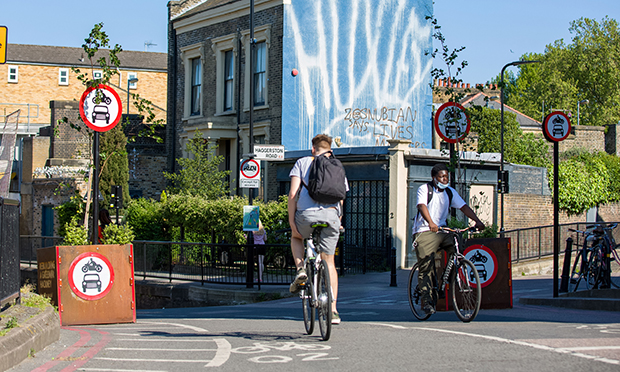High Court throws out legal challenge to Hackney’s low traffic neighbourhoods

A legal challenge by residents to the controversial low traffic network scheme in Hackney has been thrown out by the High Court.
The council closed 20 roads to through-traffic, open only to pedestrians, cyclists and emergency vehicles as part of its response to Covid.
The measures, brought in through the use of 18-month long experimental traffic orders (ETOs), were aimed at aiding social distancing, supporting walking and cycling, and improving road safety by clamping down on rat-running.
These low traffic neighbourhoods (LTNs) were introduced in Hoxton West and the Haggerston and London Fields area.
Among the businesses that contacted the council over concerns when the LTNs were proposed was 58 Gin in Haggerston.
At the time it was concentrating on making hand sanitiser for the NHS and said an unforseen consequence of the closure would have seen delivery lorries turning on a corner near a school.
Now, 14 months on, Carmen O’ Neal told the Citizen the distillery worked with officers to change the scheme there.
She said: “There is much less through-traffic.”
However, she still has to go and warn delivery drivers to avoid the route as maps have not been updated.
“We have to work with how to help the environment, but without crippling businesses,” she added.
Campaigners from Horrendous Hackney Road Closures Ltd (HHRC) took the council to court. They lodged a claim for a judicial review which alleged the council had not consulted enough and had failed to look at the impact on other roads, on air quality and on some people with protected characteristics.
They said: “LTNs have paralysed our neighbourhoods. Their roadblocks have impacted the work of our emergency services, left many elderly and disabled residents stranded in their homes, massively increased journey times, left people struggling to get to work, hospital appointments, care visits, and pushed many local businesses to the brink of failure.”
HHRC said the LTNs had transformed some streets: “Quiet residential, and even school streets, have become gridlocked, sometimes for hours at a time.
“The hum of stationary engines, the smell of fumes and blaring car horns of frustrated drivers have become all too familiar in many neighbourhoods.
“The council’s claim that these measures are creating a greener, safer, more child-friendly borough reads like a sick joke.”
However High Court judge Mr Justice Dove was not persuaded by their arguments.
One resident, Ellert Driessen, responded to the decision and explained that LTNs had changed their street: “We’ve lived on the same residential ‘main’ road, Graham Road, for over 30 years, a busy but perfectly liveable street.
“We raised a family here with three children and always walked the kids to school, used public transport and only drove long distances.
“From the moment 12 months ago when LTNs were implemented, our road is congested daily (except during lockdowns) for hours on end, six days a week.
“The court case judgement does not change the sad and unhealthy reality for Hackney’s residents.”
HHRC Ltd’s solicitor Bill Parry-Davies said: “Although HHRC Ltd’s challenge to the LTN strategy has so far failed, future decisions to make each road closure order permanent could still be individually challenged. But there have been dozens of such orders and contesting them would be a massive burden and expensive for the community and, indeed, for the council.
“Unless the strategy is overturned on appeal, or Hackney is persuaded to reverse the road closures, LTNs could become a fait accompli.”
The group is considering whether it should appeal, and if it can even afford to.
Town Hall transport boss Cllr Mete Coban said: “The Emergency Transport Plan aligns with the council’s aim to reduce toxic air pollution and reimagine the future of our neighbourhoods, but was produced in the wake of statutory guidance to reallocate road space for walking and cycling as part of the recovery from lockdown prompted by the coronavirus pandemic.
“We have always been clear that our ambitions and policies are about reducing toxic air pollution, and reimagining the future of our neighbourhoods.
“Around 40 per cent of traffic in Hackney passes through the borough without stopping, and our LTNs are focused on reclaiming our streets for local people and supporting them to safely walk, cycle and use public transport. “
He explained LTNs are part of the council’s response to the global climate emergency.
“LTNs are being rolled out under experimental traffic orders, which means that residents can share their views as the schemes are implemented,” he added.
“Thousands of residents have had their say online and in writing during the engagement period for the first stage of our LTN programme. Residents can also continue to have their say online for newer LTNs.”
Last October, Conservative councillors attempted to put an “immediate end” to the LTNs, calling on the council to “go back to the drawing board”.
Cllrs Harvey Odze and Simche Steinberger urged the council to establish where LTNs “are actually wanted or required to solve a problem”.
In June this year, residents staged a protest outside Hackney Town Hall. They said LTNs shift traffic onto main roads and do nothing to tackle pollution.
